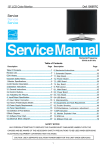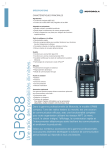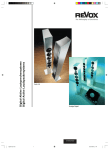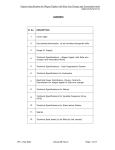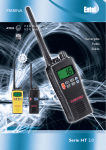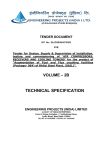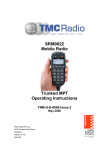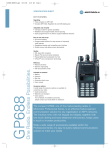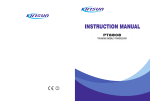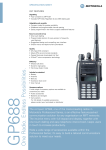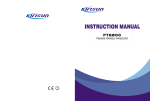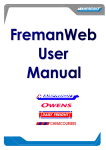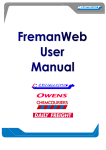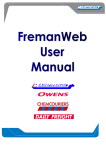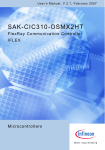Download Fylde Infrastructure
Transcript
Version: 5.30 Date: 15th April 2002 CNC ABCDEFGH 0 1 2 9 0 SERVICE N PRODUCT E B A BT © Fylde Microsystems Ltd. APPLICABILITY This document is intended as an introduction to the Fylde Microsystems Trunking product range. The information necessary to enable routine service, maintenance, and set-up work by competent engineering staff on infrastructure fitted with series IV software is contained in the full service manual which is supplied with each system sale. ASSOCIATED DOCUMENTS Operation and Service Manual for Fylde Trunked Infrastructure Inter-Regional Processor Service and Maintenance manual MHD - Message Handling Despatcher software manual PCM Switch Matrix service and maintenance manual SYSCON - System Terminal Manual for Fylde Trunking (DOS) SYSCON for NT® - System Terminal Manual for Fylde Trunking COPYRIGHT The information contained within this document remains copyright of Fylde Microsystems Limited and may be used freely in the sale and promotion of the Fylde Microsystems Limited product range. All information, either explicit or inferred, is subject to change without notice or recourse to Fylde Microsystems Limited. DISCLAIMER This document does not constitute an offer. All features and facilities described within are subject to change without notice. Fylde Microsystems Ltd. does not accept any liability whatsoever arising out of the use of this document. © Fylde Microsystems Ltd. Technical Description of FyldeSuperTrunk 2 CONTENTS INTRODUCTION .....................................................................................................................................6 Company Background .....................................................................................................................................6 The Product ......................................................................................................................................................6 MPT1327 Specification....................................................................................................................................6 Salient Issues.....................................................................................................................................................6 Design Philosophy ..........................................................................................................................6 Gradual Degradation.......................................................................................................................6 Achieving Spectral Efficiency..........................................................................................................7 Control Channel Efficiency..............................................................................................................7 Traffic Channel Efficiency ...............................................................................................................7 EMC Policy .......................................................................................................................................................7 Overall Responsibilities...................................................................................................................7 The Fylde EMC Philosophy.............................................................................................................7 The FYLDE Trunking Concept ......................................................................................................................8 The basic components of the system ...............................................................................................................9 TSC Channel Card..........................................................................................................................9 System Control Interface ..............................................................................................................11 Regional Control Processor ..........................................................................................................11 PCM Switch...................................................................................................................................11 Inter Regional Processor ..............................................................................................................12 Let’s Build a System.......................................................................................................................................13 How Do You Connect Them?........................................................................................................................18 Connecting TSC Channel Cards...................................................................................................18 Connecting the System Control Interface .....................................................................................18 Connecting to the Regional Control Processor.............................................................................18 Connecting to the PCM Switch .....................................................................................................18 Connection to the Inter Regional Processor .................................................................................18 Connecting Inter Regional Systems together ...............................................................................18 Connection to SYSCON and MHDs..............................................................................................18 FEATURES & SPECIFICATIONS.........................................................................................................19 HARDWARE SPECIFICATIONS ...............................................................................................................19 TSC Channel Card (TSCC02f) .....................................................................................................19 TSC Channel Card (TSCC03) ......................................................................................................20 System Control Interface (SCI03e) ...............................................................................................20 Regional Control Processor (RCP02e) .........................................................................................21 Single Site Interconnect Unit (part of SSTAK) ..............................................................................21 Inter-Regional Processor ..............................................................................................................21 PCM Switch Matrix........................................................................................................................22 FEATURES.....................................................................................................................................................23 Single Site Systems ......................................................................................................................23 Regional Systems .........................................................................................................................25 Inter-Regional Systems.................................................................................................................26 © Fylde Microsystems Ltd. Technical Description of FyldeSuperTrunk 3 CONTENTS Controlling the system ...................................................................................................................................27 SYSCON Features – System Control ...........................................................................................27 SYSCON Features – System Status ............................................................................................29 SYSCON Features – Subscriber Control......................................................................................33 SYSCON Features – Subscriber Status .......................................................................................36 APPENDIX.............................................................................................................................................39 Glossary of Terms ..........................................................................................................................................39 4 © Fylde Microsystems Ltd. Technical Description of FyldeSuperTrunk CONTENTS LIST of FIGURES Figure 1: 1U TSCC02f Channel Cards ....................................................................................................9 Figure : 2 TSCC03 Channel Cards..........................................................................................................9 Figure : 3 TSCC03 Field Programmer showing virtual scope. ..............................................................10 Figure 4: System Control Interface........................................................................................................11 Figure 5: Regional Control Processor ...................................................................................................11 Figure 6: 6U PCM Switch ......................................................................................................................11 Figure 7: Inter Regional Processor ........................................................................................................12 Figure 8: Control Parameters Definition ................................................................................................27 Figure 9: Applicability Map.....................................................................................................................27 Figure 10: Line Testing Thresholds (in dbm).........................................................................................28 Figure 11: System Overview..................................................................................................................29 Figure 12: RCP Status...........................................................................................................................29 Figure 13: TSC Site Status ....................................................................................................................29 Figure 14: Dynamic Activity Display.......................................................................................................30 Figure 15: Status Log ............................................................................................................................30 Figure 16: Operational Statistics............................................................................................................30 Figure 17: Error Counters ......................................................................................................................31 Figure 18: User Outputs and Alarms .....................................................................................................32 Figure 19: Customer Agreements Structure..........................................................................................33 Figure 20: Customer Agreement Record ..............................................................................................33 Figure 21: Individual Subscriber Record................................................................................................34 Figure 22: Group Subscriber Record.....................................................................................................34 Figure 23: Ident Map..............................................................................................................................35 Figure 24: Billing Factor.........................................................................................................................35 Figure 25: Billing Report Example .........................................................................................................36 Figure 26: Call Record Analysis - Graph output ....................................................................................37 © Fylde Microsystems Ltd. Technical Description of FyldeSuperTrunk 5 SECTION 1 INTRODUCTION comprehensive and exhausting series of tests under the close scrutiny of the DTI. INTRODUCTION Company Background Fylde Microsystems Ltd. specialises in the design and development of digital equipment for trunked mobile radio systems. The company, which is based in the Northwest of England, has over 15 years experience in this field. To date, Fylde Microsystems has supplied equipment into more than 50 countries throughout the world. The Product FyldeSuperTrunk radio systems and ancillary equipment conform to the MPT1327 standard. Systems range from single-site, single channel, up to wide-area networks of up to 800 sites. MPT1327 Specification The Department of Trade and Industry (DTI) in the U.K publish this specification. It details a common signalling standard for land based trunked-radio systems operating primarily in the UK’s VHF Band III Sub-band 1 & 2. This protocol has become a de-facto standard for trunking systems across the world. Fylde were pleased to be represented on the original MPT1327 drafting committee from the Spring of 1985 onwards, and thus have a complete understanding and extensive experience of the protocol, its workings and methods. In fact Fylde are probably unique in that their representative is also responsible for the design of the hardware and software for their range of mobile radio unit signalling boards. MPT1343 is the "AIR INTERFACE SPECIFICATION" intended to ensure that mobiles behave correctly on MPT1327 networks thus providing true compatibility between radio units and systems originating from differing manufacturers. All new radio unit signalling boards from Fylde Microsystems meet both MPT1343 and MPT1352 specifications before they are released onto the market. Salient Issues Design Philosophy Modular design and construction allows the system to be expanded or contracted as operational experience is gained. Any number of RF channels from 1 to 24 can be accommodated on a single site. Since each sub-rack houses a complete channel controller, channels may be added or removed simply. No software changes are necessary; the system automatically reconfigures itself. In fact changes may be made with the system 'live' to minimise disruptions to service. Single site installations can be upgraded to multi-site later by adding the Regional Control Processor. No software upgrades are required and there is no redundant hardware either. Gradual Degradation Gradual degradation is built into the system to greatly increase reliability and quality of service. If the System Control Interface fails, the TSC Channel Cards will continue to process traffic. Of course System Control Interface functions will cease and all subscribers will be 'white-listed' in this case. If a TSC Channel Card or its associated RF Equipment fails, then it will be taken out-ofservice automatically and the failure reported. Should a Channel Card fail on a typical 5channel site, system capacity will be reduced by only 20%. Functionality remains unchanged and there is no messy fall-back mode. Should the RCP fail in a multi-site system the TSC sites will still operate in local mode with no loss of performance. MPT1352 is the "PERFORMANCE/TEST SPECIFICATION" for radio units operating under the above standards. To approve a radio unit to MPT1352, it must undergo a 6 © Fylde Microsystems Ltd. Technical Description of FyldeSuperTrunk SECTION 1 INTRODUCTION Achieving Spectral Efficiency In the UK, trunking systems were promoted from the start as a means of improving spectral efficiency. Fylde Trunking systems aim to be as efficient as possible in both control channel signalling and traffic channel management. Control Channel Efficiency Today, AVL, e-mail, and other short data messages put an increased burden on the control channel. Care must be taken to maximise data throughput whilst minimising delays to speech calls. Fylde achieve this through careful design honed by over 15 years of practical experience in system design. In practice: • • • No unnecessary wait states on the control channel. Specific site registration, rather than multiple registration, avoids duplicate AHOY messages on adjacent cells. High-speed real-time processing ensures that call processing begins as soon as a request is received. There is no processor latency. Traffic Channel Efficiency • Automatic Group Roaming ensures that traffic channels will be allocated only on sites where members of the group are registered. EMC Policy Overall Responsibilities The overall responsibility for compliance with EMC Directive 89/336/EEC(143) rests with the complete radio system supplier. Where Fylde supply complete turnkey systems, we will ensure that all third-party supplied parts either conform in isolation or have the necessary approved screened casings fitted. The Fylde EMC Philosophy In order to simplify construction of systems for all customers, modules are certified for compliance individually unless specifically otherwise stated. Fylde have taken a great deal of care in manufacturing their equipment so that unsightly ferrite cores on interconnection leads are not required. Fylde realise that in many countries traffic channels are a scarce resource. It is therefore essential that systems are quick to react when calls are held on queue. Consider a onesecond delay when each traffic channel becomes free. On a 20-channel site that would comprise a waste of 20 call-seconds on that site. Such resource could be used to support a better grade of service or additional users. Below are some of the features that Fylde provide to help the network operator extract the best return from valuable spectrum: • • • • Dynamic Call Timer Vote Now Advice Low processor latency to ensure traffic channels stand idle for as short a time as possible when they become free. Fine-grained subscriber control to accurately control features and coverage on a radio by radio basis. © Fylde Microsystems Ltd. Technical Description of FyldeSuperTrunk 7 SECTION 1 INTRODUCTION without the need to change software or even power off the existing equipment. The FYLDE Trunking Concept Traditionally, communications systems comprise of a large central processor with, sometimes, a separate backup system in case of equipment failure. These systems do not exhibit any gradual degradation and a single failure can present a complete loss of service to the user. • Scalable - Single site installations may be upgraded to multi-site at any time without any hardware being made redundant. • Full call logging. Over 20 parameters stored for each call. Wherever possible, the Fylde Trunking System uses distributed processing, structured so that equipment failures only have a limited effect on system operation i.e. on a radio site each RF channel has a digital processor card associated with it. Therefore, should any 1 channel fail (Transmitter, Receiver or Processor) the other channels can continue normal operation. If a 5-channel system is considered, a failure of 1 channel simply reduces system capacity by 20%. In fact, 4 channels could fail and the system would actually operate in single channel mode! No messy fall-back mode is required for the radio units so that impact on the user is kept to a minimum. • Operational Statistical Analysis graphs help determine system throughput and quality of service. • Control Parameters can be set for each individual site. These may be changed automatically by time of day or day of week to optimise configuration. • 12 selectable call timers, including a Dynamic Call Timer, allows for total operator flexibility. • EVERY radio unit is validated at every call attempt to ascertain that the requested service is available to that radio unit. Modular construction allows easy configuration changes to the system. Each site may have from 1 to 24 RF channels. Each regional system may comprise up to 10 of these sites, and 16 regions may be connected to an Inter-Regional Processor. In turn, 5 IRPs can be networked, making a total network capacity of 800 sites. • EVERY radio unit has over 25 control fields associated with it, all accessible from the system management terminal for the ultimate in subscriber control. • Comprehensive system status reporting. • Control of the system and individual subscribers by time and day. • PSTN/PABX access at both site and regional level. All site interconnections may be realised with low cost fixed-links to minimise operating costs. Of course, where they can be provided, digital circuits and microwave form an excellent bearer for site interconnection. Even when using low cost lines system performance is good. Fylde Trunking exhibits the fastest local call set-up times possible using the MPT1327 protocol. Inter-site call set-up time is approximately 2.0 seconds with the Go-To-Channel messages (these are the messages which switch the mobiles to a traffic channel) synchronised to within 0.5 seconds. Group calls within a single cell are set-up in just 217 ms. System facilities are not compromised in achieving this, here are a few of the features available: • Modular construction - channels or even complete sites may be added or removed 8 © Fylde Microsystems Ltd. Technical Description of FyldeSuperTrunk SECTION 1 INTRODUCTION The basic components of the system TSC Channel Card vii) The TSC03 channel card incorporates all the functionality of previous channel cards but also adds the following features i) Smaller size allowing up-to 4 units to be fitted into a 1U tray. ii) Flash configuration and upgrade. iii) Optional plug in line interface (LIFU) for inter-site audio switching including line mixing for inter-site group calls and automatic line loop-back for line testing. iv) Soft-pot control of FFSK input and output levels. v) Soft-pot control of inter-site audio line levels (when LIFU is fitted). vi) Built in virtual scope alignment tool for rapid in the field configuration and alignment. Figure 1: 1U TSCC02f Channel Cards Figure : 2 TSCC03 Channel Cards The TSC Channel Card performs all the major MPT1327 trunked radio functions. It controls the radio base station associated with it and manages any line interfaces that may be optionally connected, so that audio paths may be correctly routed for both local and intersite calls. A TSC Channel Card can operate on its own as a single channel MPT1327 repeater. No other processors whatsoever are necessary. Monitor various alarms and provide visual indications of status. A summary of what you can do with TSC Channel Cards on their own: i) Local RQS and RQE speech and nonprescribed data(NPD) calls ii) Local RQQ status calls iii) Local Short Data Message (SDM II) calls up to 184 bits free-format or MPT1343 types iv) With more than one channel - call queuing for channel v) With more than one channel - queuing for 'called party busy' vi) Operates with default control parameters - alterable with standard programmer © Fylde Microsystems Ltd. Technical Description of FyldeSuperTrunk 9 SECTION 1 INTRODUCTION Figure : 3 TSCC03 Field Programmer showing virtual scope. 10 © Fylde Microsystems Ltd. Technical Description of FyldeSuperTrunk SECTION 1 INTRODUCTION System Control Interface Regional Control Processor Figure 5: Regional Control Processor Figure 4: System Control Interface The System Control Interface operates in conjunction with the TSC Channel Cards to form the complete trunking site. Its primary function is to connect the channel cards to the outside world. This could be a system terminal PC for a single-site system, or the Regional Control Processor if a multi-site wide area network. However, several other important facilities are provided as well: i) Individual subscriber validation everyone is now 'black listed' until a record enabling access is entered. ii) Call records stored on a call by call basis. iii) Call statistics are compiled over a rolling 24 hour period. iv) Operational control parameters can be altered via the system terminal v) System alarms are presented to the system terminal vi) Rack temperature may be monitored remotely via the system terminal vii) Auxiliary monitoring and output drivers available for custom use, accessible via the system terminal. viii) Multi-site connection interface. ix) Interface for PSTN interconnect. The Regional Control Processor is used to connect together up to 10 System Control Interfaces (10 sites) to form a regional network. Although schematic layouts suggest that this is a central processing element, in fact it is essentially a router of calls - but it does posses one or two value-added extras: i) Gateway to the PSTN via a maximum of 24 lines ii) Gateway to up to 8 PABXs via a maximum of 24 lines iii) Access to 16 PC-based line connected dispatchers iv) Call Diversion facilities v) Pooled Channels (frequency sharing) vi) Expansion port to the Inter-Regional Processor for very large networks of up to 800 sites PCM Switch Figure 6: 6U PCM Switch (2U 4 port version also available) The PCM Switch Matrix provides for all the switching of speech (or non-prescribed data) © Fylde Microsystems Ltd. Technical Description of FyldeSuperTrunk 11 SECTION 1 INTRODUCTION between radio sites, line dispatchers, the PSTN, or PABXs. There is no call set-up logic as such in the switch, but it does provide intelligent processing to interface with phone systems e.g. E & M interfacing and DTMF dialling. 10 i.p.s. dialling is available outbound from the switch only. All common 2-wire and 4-wire analogue private circuits can be accommodated. All barriers and interfaces are built into every 4-port card as standard so that configuration and wiring is very straightforward. Inter Regional Processor Figure 7: Inter Regional Processor The Inter Regional Processor ties together as many as 16 regions where 160-site capacity is required. IRPs can run in parallel, connected by LAN or high-speed WAN running TCP/IP, to give 800-site coverage. Inter-regional working is seamless and fully automatic. Users may roam anywhere in the network, so long as they are authorised by the system management terminals (SYSCON) to do so. A PCM Switch may be optionally connected to the IRP to enable multi-region group calls, or simply to maximise fixed-link efficiency. 12 © Fylde Microsystems Ltd. Technical Description of FyldeSuperTrunk SECTION 1 INTRODUCTION Let’s Build a System Step 1: First a repeater is required... Step 2: Attach a TSC Channel Card for MPT1327 operation Step 3 Add more channels Step 4: Add an SCI for subscriber validation and system control. © Fylde Microsystems Ltd. Technical Description of FyldeSuperTrunk 13 SECTION 1 INTRODUCTION Step 5: Connect SYSCON to the SCI for network management and control. 14 Step 6: Add a local PCM Switch or SSTAK for PSTN Interconnect. © Fylde Microsystems Ltd. Technical Description of FyldeSuperTrunk SECTION 1 INTRODUCTION Step 7: Going regional – up to 10 sites © Fylde Microsystems Ltd. Technical Description of FyldeSuperTrunk 15 SECTION 1 INTRODUCTION Step 8: Connecting regions – 16 regions per IRP x 5 IRPs = 800 Sites 16 © Fylde Microsystems Ltd. Technical Description of FyldeSuperTrunk SECTION 1 INTRODUCTION Step 9: Connecting upto 800 sites – 5 IRPs © Fylde Microsystems Ltd. Technical Description of FyldeSuperTrunk 17 SECTION 1 INTRODUCTION How Do You Connect Them? Connecting TSC Channel Cards TSC Channel Cards talk to one another, and the SCI, via a bi-directional serial bus running at 63,000/126,000 Baud. The SIO Bus uses a proprietary protocol optimised for MPT1327 applications, with mild data compression to reduce processing overhead and provide additional security. A single twisted-pair overall screened cable makes for simple and robust connection. Connecting the System Control Interface On one side the System Control Interface communicates with TSC Channel Cards, on the other, with the outside world. This would be a system terminal (SYSCON) on single site systems, or the Regional Control Processor if multi-site. RS232 port A is used for conveying data at rates of between 1200 to 19200 Baud. The link protocol is binary, with mild compression yielding an approximate 3:1 advantage over an equivalent ASCII method. With appropriate interfacing, almost any bearer that exhibits a low end-to-end delay may be used, such as 2/4-wire, microwave, UHF radiolink, or digital 64Kbits/E1/T1. RS232 port B can drive a PCM Switch to provide site-level connection to the PSTN. RS232 port B is also used for software upgrading and configuration. In multi-site systems, speech circuits are fed directly from the base station audio interfaces to the regional node via 2/4-wire analogue, or 64Kbits/T1/E1 digital with the appropriate interfacing equipment. Connecting to the Regional Control Processor All control links to the RCP may run at any rate between 1200 and 19200 Baud. And with the exceptional of the connection to the PCM Switch, the Fylde Binary Links protocol as described for the SCI above, is used. Connecting to the PCM Switch Audio interfaces are provided for 2/4-wire analogue private circuits, 2-wire telephone extension mode (POTS), and E&M signalling to DC5A standard for telephones. The PCM Switch is approved for operation in many parts of the world. 18 Connection to the Inter Regional Processor All control links to the IRP may run at either 9600 or 19200 Baud. And with the exception of the connection to the PCM Switch, the Fylde Binary Links protocol as described for the SCI above, is used. Connecting Inter Regional Systems together Up to 5 inter regional processors (IRP’S) can be networked together using TCP/IP connections over a LAN or WAN. An IRP server, based on similar hardware to the standard IRP will act as the master controller for the network. Each IRP will have a 10/100 Base T network card with suitable Packet TCP/IP drivers. This may then be connected to any suitable ethernet/token ring LAN/WAN or a dedicated LAN. Each IRP and the IRP server will have a specific IP address, which will be fixed at commissioning. (Note: care must be taken to maximise the performance of the LAN/WAN for IRP traffic, otherwise call setup time may be affected.) All call setup and data transfer between IRP’s will be via the TCP/IP links to and from the IRP server. The IRP server may also have an associated PCM switch. Audio links between the IRP’s may be routed via the PCM switch connected to the IRP server, or direct between the IRP’s. An optional IRP server status monitor may also be connected to the IRP server network. This is a Windows based software package which can display the current status of the IRP server and links, including the TCP/IP loading, line status, alarms, calls in progress etc. Connection to SYSCON and MHDs The system terminal (SYSCON) and Message Handling Despatchers (MHDs) can connect into the host at any rate between 1200 and 19200 Baud. The Fylde Binary Links protocol as described for the SCI above, is used. © Fylde Microsystems Ltd. Technical Description of FyldeSuperTrunk SECTION 2 Features & Specifications FEATURES & SPECIFICATIONS HARDWARE SPECIFICATIONS TSC Channel Card (TSCC02f) DESCRIPTION POWER REQUIREMENTS (operational) – DC only POWER REQ. (Maximum current @ switch on) OPERATING TEMPERATURE RANGE OPERATING HUMIDITY RANGE MAXIMUM number of RF Channels per site MINIMUM number of RF Channels per site MAXIMUM Speech /NPD Call Queue Depth MAXIMUM Short Data Call Queue Depth MAXIMUM population (not limited by ch. card) DEDICATED Low Forward Power Alarm DEDICATED High Reverse Power Alarm DEDICATED Line Interface Unit Alarm DEDICATED Receiver Mute Alarm UNDEDICATED Alarms BASE STATION INTERFACE connectors SIO BUS INTERFACE connector POWER connector APPROVALS (TSCC02f) …… …… …… …… …… …… …… …… …… …… …… …… …… …… …… …… …… …… SPECIFICATION 8-18Vdc @ 375mA 10A pk / 250µS max. -10°C to + 70°C 10% to 90% n/c. 24 01 31 16 1,036,800 TTL input TTL input TTL input TTL input 3 TTL inputs 2 x 15 way D-types 9 way D-type 9 way D-type EMC Directive 89/336/EEC(143) © Fylde Microsystems Ltd. Technical Description of FyldeSuperTrunk 19 SECTION 2 Features & Specifications TSC Channel Card (TSCC03) DESCRIPTION POWER REQUIREMENTS (operational) – DC only POWER REQ. (Maximum current @ switch on) OPERATING TEMPERATURE RANGE OPERATING HUMIDITY RANGE MAXIMUM number of RF Channels per site MINIMUM number of RF Channels per site MAXIMUM Speech /NPD Call Queue Depth MAXIMUM Short Data Call Queue Depth MAXIMUM population (not limited by ch. card) DEDICATED Low Forward Power Alarm DEDICATED High Reverse Power Alarm DEDICATED Line Interface Unit Alarm DEDICATED Receiver Mute Alarm UNDEDICATED Alarms BASE STATION INTERFACE connectors SIO BUS INTERFACE connector POWER connector …… …… …… …… …… …… …… …… …… …… …… …… …… …… …… …… …… Line Interface Unit connector Line Interface Unit Interface Line Interface Levels APPROVALS (TSCC03) …… SPECIFICATION 8-18Vdc @ 225mA 10A pk / 250µS max. -10°C to + 70°C 10% to 90% n/c. 24 01 31 16 1,036,800 TTL input TTL input TTL input TTL input 3 TTL inputs 25 way D-type 9 way D-type Powered via BASE STATION interface connector RJ45 4 Wire 600 ohm -20dBm to 0dBm softpot adjustable. EMC Directive 89/336/EEC(143) System Control Interface (SCI03e) DESCRIPTION POWER REQUIREMENTS (operational) – DC only OPERATING TEMPERATURE RANGE OPERATING HUMIDITY RANGE MAXIMUM number of Validatable Radio Units MAXIMUM item billing store capacity INTERFACE to System Terminal / RCP (Port A) INTERFACE to Programming Terminal and optional local PCM Switch (Port B) SIO BUS INTERFACE connector POWER connector INTERFACE to Remote Monitoring APPROVALS (SCI03e) 20 …… …… …… …… …… …… …… …… …… …… …… SPECIFICATION 8-18Vdc @ 200mA -10°C to + 70°C 10% to 90% n/c. > 100,000 Idents > 20,000 calls RS232 (9 way D-type) RS232 (9 way D-type) 9 way D-type 9 way D-type 15 way sub D-type EMC Directive 89/336/EEC(143) © Fylde Microsystems Ltd. Technical Description of FyldeSuperTrunk SECTION 2 Features & Specifications Regional Control Processor (RCP02e) DESCRIPTION POWER REQUIREMENTS (operational) - DC ONLY OPERATING TEMPERATURE RANGE OPERATING HUMIDITY RANGE MAXIMUM number of TSC Sites MAXIMUM number of PSTN phone lines MAXIMUM number of PABX phone lines MAXIMUM number of VDU Line Dispatchers MAXIMUM number of Inter-regional gateways MAXIMUM number of PCM switch interfaces MAXIMUM number of System Terminal interfaces MAXIMUM number of simultaneous speech calls All INTERFACE TYPES APPROVALS ...... ...... ...... ...... ...... ...... ...... ...... ...... ...... ...... ...... ...... SPECIFICATION +10 to 18VDC @ .5A -10°C to + 70°C 10% to 90% n/c. 10 24 24 on 8 exchanges 16 1 1 2 64 RS232 - 9 way D-type EMC Directive 89/336/EEC(143) Single Site Interconnect Unit (part of SSTAK) DESCRIPTION POWER REQUIREMENTS (operational) DC ONLY OPERATING TEMPERATURE RANGE OPERATING HUMIDITY RANGE MAXIMUM number of TSC Sites MAXIMUM number of PSTN phone lines MAXIMUM number of PABX phone lines MAXIMUM number of VDU Line Dispatchers MAXIMUM number of Inter-regional gateways MAXIMUM number of PCM switch interfaces MAXIMUM number of System Terminal interfaces MAXIMUM number of simultaneous speech calls ...... ...... ...... ...... ...... ...... ...... ...... ...... ...... ...... All INTERFACE TYPES APPROVALS ...... ...... SPECIFICATION +10 to 18VDC @ .5A -10°C to + 70°C 10% to 90% n/c. 1 24 24 on 8 exchanges 16 0 1 1 39 (23 traffic channels and 16 VDU despatchers). RS232 - 9 way D-type EMC Directive 89/336/EEC(143) Inter-Regional Processor DESCRIPTION POWER REQUIREMENTS - AC ONLY OPERATING TEMPERATURE RANGE OPERATING HUMIDITY RANGE MAXIMUM number of Regional Interfaces MAXIMUM number of speech ccts. per region MAXIMUM number of PCM switch interfaces MAXIMUM number of Diagnostic Terminals MAXIMUM number of simultaneous speech calls ...... ...... ...... ...... ...... ...... ...... ...... All INTERFACE TYPES ADVANTECH industrial PC chassis ...... ...... SPECIFICATION 110/240VAC @ 500VA 0°C to + 55°C 10% to 90% n/c. 16 24 1 (optional) 1 64 (128 port switch capacity ÷ 2) RS232 - 25 way D-type EMC Directive 89/336/EEC(143) © Fylde Microsystems Ltd. Technical Description of FyldeSuperTrunk 21 SECTION 2 Features & Specifications PCM Switch Matrix DESCRIPTION POWER REQUIREMENTS - AC POWER REQUIREMENTS - DC OPERATING TEMPERATURE RANGE OPERATING HUMIDITY RANGE MAXIMUM number of PCM ports MAXIMUM number of phone interfaces CONTROL INTERFACE TYPE APPROVALS 22 ...... ...... ...... ...... ...... ...... ...... ...... SPECIFICATION 110/240VAC @ 100VA 11-14VDC @ 10A -10°C to + 70°C 10% to 90% n/c. 192 2 per 4-port card RS232 - 25 way D BABT – UK EMC Directive 89/336/EEC(143) © Fylde Microsystems Ltd. Technical Description of FyldeSuperTrunk SECTION 2 Features & Specifications FEATURES Single Site Systems 1) DESCRIPTION Alarms on Transmitter, Line Interface, and controller card with optional forwarding to e-mail destinations (e.g. mobile phones). 2) Auxiliary Alarm inputs / control outputs with optional alarm forwarding to e-mail destinations (e.g. mobile phones). 3) Broadcast Group Calls. 4) Call Statistics. 5) Call Type-Dependant Timers. 6) CBS Share. 7) Channel Segregation. 8) Control Channel Anti-Jamming. 9) Dynamic Call Timer. 10) Extended Call Timer. 11) Fine-Grained Subscriber Control. 12) Fixed Call Timers. 13) FLASH reprogramming and Configuration. 14) Group calls with 3 basic priority levels. 15) Individual calls with 3 basic priority levels. 16) Inter-prefix calls. 17) Item Billing of all call types with Call Record Analysis Tools. 18) Late Entry Group Calls. FUNCTION Monitoring & reporting of alarms to the system terminal with forwarding to e-mail destinations such as WAP phones and pagers. 5 analogue (0-51 volt) and 2 TTL inputs with 5 o/c outputs provided per site. The user can define alarm thresholds. Forwarding of auxiliary alarms to e-mail destinations such as WAP phones and pagers is also provided. Group calls where recipients cannot transmit. Traffic channel usage statistics are recorded over a rolling 24-hour period as per UK specification MPT1318. Can be selected to override other call timers for: Non-Prescribed Data Calls, Emergency Calls, PSTN Calls, and PABX Calls. A trunked channel can share a frequency with a Community Base Station (repeater). Either the CBS or trunking may be assigned priority. Allows certain channels to be used only by defined radio sub-groups. Protection is provided against jamming or interference. Modifies maximum call duration dependent upon system load. Maximum call duration upto 18 hours is available for specialist applications. 25 fields provide control on a subscriber by subscriber basis. 6 Fixed call timers available on a subscriber basis. TSCC02e Channel Cards can be upgraded to Flash by way of plug-in modules. TSCC02f and TSCC03 units are flash equipped from new. SCI03 System Control Interfaces are also flash equipped. Normal, high, and emergency priority levels are available for group calls. Number of priority levels is multiplied when Channel Segregation is used. Normal, high, and emergency priority levels are available for individual or private calls. Number of priority levels is multiplied when Channel Segregation is used. Both common-prefix and inter-prefix addressing is supported for all call types. Over 20 parameters are recorded for download to the system terminal. Advanced sorting and filtering is provided with outputs to tables, printed reports, or colour graphs. File format is industry standard MDB or CSV, for easy export and post-processing. Repeat Go-To-Channel messages are available during group calls for certain applications. © Fylde Microsystems Ltd. Technical Description of FyldeSuperTrunk 23 SECTION 2 Features & Specifications 19) DESCRIPTION Maximum subscriber capacity > 16,000. 20) Maximum call record storage > 20,000. 21) MPT1327, MPT1343, and CPS numbering. 22) Non-prescribed Data calls with 3 basic priority levels. 23) Pre-emptive Emergency Call. 24) PSTN Calls. 25) PSTN Destination Barring. 26) PSTN Dial string filtering. 27) 28) Queuing on all call types for resources and for called party busy. Rack Temperature, SCI supply, and Lithium Battery monitoring at every site. 29) Remote Diagnostics. 30) 31) 32) Remote Site Control. Remote Site Status. Status Calls. 33) Short Data Messages. 34) Soft-Alignment. 35) Time-tagged System Control. 36) Time-tagged Customer Control. 37) Traffic Channel Protection. 24 FUNCTION Unlikely to be a limit on a single site system. Provides a buffer in case regular downloads to the system terminal cannot be made. In addition to the basic MPT1327 numbering, MPT1343, and Chinese Police System schemes are supported. Normal, high, and emergency priority levels are available for individual and group calls. Number of priority levels is multiplied when Channel Segregation is used. Full Emergency pre-empt for channel and ANY other conflict. Up to 23 lines can be connected at site level by connection of a PCM switch directly to the SCI. 1st 4 digits of dialling string checked against 8 entry barring table. Includes wildcards. Caters for PSTN exchanges that require area code digits to be stripped and other complex conditions. Ensures the maximum effect is derived from the trunking philosophy. Provided by SCI03 to local display & SYSCON. Fylde Microsystems can perform in depth diagnostics by dial-up access to any system equipped with a suitable modem. Inhibit or restart any channel from system terminal. Display of current site usage on system terminal. 30 x 5-bit status fields available for custom use. Up to 184 bits of free-format data may be sent on the control channel (or MPT1343 format). TSCC03 channel cards allow for all FFSK and line levels to be set via the Field Programmer (Flash and configuration program). Built-in “Virtual Scope” displays FFSK and line signals for precision alignment. Up to 16 sets of control parameters can be defined to become automatically active at predefined times/days. Control by time of day of radio unit’s ability to access the system. Protection is provided against interference or faulty receiver equipment. © Fylde Microsystems Ltd. Technical Description of FyldeSuperTrunk SECTION 2 Features & Specifications Regional Systems Regional systems can comprise up to 10 radio sites. Features include all those listed for single site installations plus: DESCRIPTION 38) Additional PSTN Interconnect. 39) Automatic Group Roaming. 40) Automatic Line Testing. 41) Call Diversion. 42) Internet connection & E-Mail services. 43) Inter-site calling of all call types including group calls. 44) Line Connected VDU Dispatchers. 45) Maximum subscriber capacity > 100,000. 46) Maximum call record storage > 20,000. 47) PABX Interconnect. 48) Pooled Channels. 49) PSTN Shortform Dialling. 50) Vote Now Advice. FUNCTION Inbound and outbound services via up to 24 PSTN phone lines. Ensures that traffic channels are allocated only on cells where members of the group are registered. All circuits are continuously tested and faults reported via the system terminal. Call divert to another radio, a group, or a line connected destination. A gateway to the internet (or other network) is provided by the Line Connected VDU Dispatcher (see below). Short text e-mails to radio units can be accomplished by conversion to Short Data Messages. Conversion to Non-Prescribed Data is also possible for long transactions. Full roaming and automatic call routing with control of coverage via system terminal. Up to 16 dispatchers can be accessed each with network operator definable numbers which may include wild prefix. Sufficient to realise national systems in many countries. This is a cache store additional to the capacity provided at every radio site. Up to 24 lines can be allocated in any combination with up to 8 different exchanges. Allows the use of co-frequency channels in areas of overlapping radio coverage. Global shortform PSTN destinations definable by network operator. Advises radio units of adjacent sites where signal strength could be better © Fylde Microsystems Ltd. Technical Description of FyldeSuperTrunk 25 SECTION 2 Features & Specifications Inter-Regional Systems Inter-regional systems provide all the major call types over the whole system. DESCRIPTION 51) Automatic PSTN routing 52) Alternate speech call routing. 53) Full Inter-Regional statistics. 54) Home PABX 55) Inter-Regional calls with fast call set-up. 56) Inter-regional Group Calls 57) Inter-regional Line Testing 58) Wide-Area expansion 26 FUNCTION Calls from the PSTN will be routed through the IRP to the called party wherever registered. With the optional PCM switch at the interregional node, maximum economy of speech circuits between regions can be achieved. Inter-regional usage statistics and registration change logs are available at the IRP. Calls to a PABX are routed back to the caller’s ‘home region’ (RCP) so that connection to the appropriate exchange is made. Full seamless roaming over 160 radio sites per IRP. Call set-up times are increased by less than 350mS over regional calls. Must have the optional PCM Switch to enable this feature. All circuits are continuously monitored and faults reported to the system terminal. Upto 5 IRPs can be networked via economical TCP/IP control links to allow 800 sites to be interconnected. © Fylde Microsystems Ltd. Technical Description of FyldeSuperTrunk SECTION 2 Features & Specifications SYSCON Features – System Control Controlling the system Running under Windows™ NT4 on a PC with 200MHz processor and 32Mbytes of RAM or better, SYSCON performs all network and subscriber management functions. Industry standard file formats are used to simplify export and post-processing of data by Microsoft Office™ applications. NOTE: MICROSOFT OFFICE and WINDOWS trademarks of the Microsoft Corporation. are registered As many as 16 sets of control parameters are defined, assigning to each site in the region as required. In the example below, Sunley Towers site is using 3 parameter sets: ‘Sunley day time’, ‘Sunley busy hours’, and ‘Sunley weekend’. Once data has been transferred to the system, control sequences will change automatically dependent upon time and day. SYSCON need not remain on line. Figure 8: Control Parameters Definition Figure 9: Applicability Map © Fylde Microsystems Ltd. Technical Description of FyldeSuperTrunk 27 SECTION 2 Features & Specifications Pooled Channels allows for the reuse of frequencies in overlapping coverage areas. Up to 6 channels can be pooled which will: • • • • For single cell calls – ensure that a pooled channel is used only on one radio site at one time. For dual-cell calls – ensure, as far as is possible, that the same pooled channel is used on both sites thus utilising just one frequency pair instead of two. NOTE: Pooled Channels cannot be used if multi-site group calls are to be made on the system. Channel Configuration makes it easy to: • • • Force channels to handle only multi-site calls. Instruct channels to share frequencies with community repeaters (CBS Share). Reboot channels. Line Testing is crucial if line faults are to be detected and lines inhibited from use before end-user dissatisfaction occurs. Since the fixed-link technology connecting radio sites could differ across a region, SYSCON allows for a line loss threshold to be entered individually for each port. Channels associated with failed lines are automatically prevented for handling multi-site calls until the fault is rectified. Inhibit channels. Restrict channels to handle only local calls. Figure 10: Line Testing Thresholds (in dbm) Vote Now Advice controls the voting instructions that the system periodically transmits to radio units. Flexibility in use is assured through the ability to enter either RF channel numbers or site names into the voting list. The duration between voting messages may be specified between 20 seconds and 4 minutes. can nevertheless reduce the amount of inbound dialling required by a telephone user. Just 3 digits are required, these being assigned to as many as 1000 users. Low Level reset allows the operator to clear any memory store, or reboot any processor form the SYSCON terminal. PSTN Translation is designed to take IDD (Inbound Direct Dialling) strings of 3 digits. Where IDD is not available PSTN Translation 28 © Fylde Microsystems Ltd. Technical Description of FyldeSuperTrunk SECTION 2 Features & Specifications SYSCON Features – System Status Sophisticated status and error reporting ensure that the health of a Fylde Trunking system need never be left to chance. System Overview provides an ‘at a glance’ report on the region. Figure 12: RCP Status Site Status takes a close look at equipment at the radio site: Figure 11: System Overview Regional Control Processor Status reports on all links, lines, and memory modules associated with this regional controller. • • • • Transmitter and receiver condition TSC Channel Card condition System Control Interface memory status. Auxiliary statuses such as, rack temperature, SCI supply, lithium battery condition, and any user-defined inputs. Figure 13: TSC Site Status © Fylde Microsystems Ltd. Technical Description of FyldeSuperTrunk 29 SECTION 2 Features & Specifications Dynamic Activity Display screen updates every 10 seconds with details of users currently on the system. Each site is shown separately with tallies of calls on channel and calls on queue. The top 5 channels are shown in detail. Figure 15: Status Log Operational Statistics enable the network operator to determine the actual load experienced by radio sites and fixed-link speech paths to the regional node. This information can be used to fine-tune the system and ensure that all expensive resources are used to maximum benefit. These statistics meet the requirements laid down in MPT1318. Figure 14: Dynamic Activity Display A Status Log records the last 300 events for quick and easy revue. All entries are time and date stamped. When the store is full, the new one replaces the oldest entry. Position cursor over data for readout. Figure 16: Operational Statistics 30 © Fylde Microsystems Ltd. Technical Description of FyldeSuperTrunk SECTION 2 Features & Specifications Error Counters show the state of all the control links running to the Regional Control Processor. Good links are fundamentally important to the correct operation of any network. To know exactly the error performance of the links is crucial to the well being of the system. Eight parameters are monitored for each link: • • • • When counters are reset. the time/date is noted. In this way ‘error-rate’ over a period may be known. • • Line Looping – some fixed-link providers test lines with warning creating havoc for users. Spurious Rx – microwave in particular can produce random spurious noise on control links. Framing – indicates noise or jitter on the link. • • Overrun – indicates software error in RCP. Parity – indicates noise or jitter on the link. Time-out – indicates noise, jitter, or a line break condition. Sumcheck –indicates noise or jitter on the link. Drop-out – indicates when the ARQ (retry) logic has failed to maintain the link. Figure 17: Error Counters Auxiliary Alarms are provided at each and every site, a number of which are available for free use by the network operator. In summary each site provides: • • 5 discrete open-collector outputs capable of sinking 100mA. 5 analogue inputs of range 0-51volts with a resolution of 200mV. Alarm thresholds may be defined independently with either a positive or negative slope, and variable hysteresis. • Alarms are reported to SYSCON and forwarded to e-mail in the same manner as the main system alarms. In the example overleaf, 2 outputs have been assigned to test start the diesel generator and to switch over to a standby antenna system. Generator running and antenna switch confirmation is fed in the 2 TTL discrete inputs. Analogue channel 0 has been allocated to measuring the diesel generator fuel level. An alarm will occur when the fuel level drops too low. © Fylde Microsystems Ltd. Technical Description of FyldeSuperTrunk 31 SECTION 2 Features & Specifications Analogue channel 1 is measuring the diesel generator speed, an alarm being generated if RPM is too high. Analogue channel 2 is tied to the main 12v DC supply rail. There is an active alarm state here since the measured voltage has dropped to 11.8v, below the threshold. Figure 18: User Outputs and Alarms 32 © Fylde Microsystems Ltd. Technical Description of FyldeSuperTrunk SECTION 2 Features & Specifications SYSCON Features – Subscriber Control Customer Agreement Record (e.g. company or department) Every radio unit and line despatcher (MHD) on the system must first be validated. SYSCON has a Customer Agreements database to hold the necessary control information. This structure aims to: • Individual Subscriber Records Group Subscriber Records • Keep in one place all subscriber records associated with the end-user fleet, whether this is a company (public access systems) or a department (private access system). Force common-prefix calls between members of the same fleet so maximising system efficiency. A very high level of control is provided both for Individual and Group subscribers. Figure 19: Customer Agreements Structure Figure 20: Customer Agreement Record © Fylde Microsystems Ltd. Technical Description of FyldeSuperTrunk 33 SECTION 2 Features & Specifications Figure 21: Individual Subscriber Record Figure 22: Group Subscriber Record 34 © Fylde Microsystems Ltd. Technical Description of FyldeSuperTrunk SECTION 2 Features & Specifications SYSCON also provides an easy way to find room to fit additional fleets. Ident Map shows ‘at a glance’ where space is available. Figure 23: Ident Map In telephony, it is normal practice to charge different rate dependent upon time of day and day of week. Fylde have incorporated this feature into radio trunking. Four charge bands can be defined ranging from 0% to 1000%. SYSCON multiplies actual call time call by the billing factor, both fields appearing in billing reports. Figure 24: Billing Factor © Fylde Microsystems Ltd. Technical Description of FyldeSuperTrunk 35 SECTION 2 Features & Specifications SYSCON Features – Subscriber Status Data from every call is recorded so that the usage of every subscriber on the network is accurately recorded to a resolution of 1 second. Records can be used to produce item billing or exception reports, or merely used as a background check on the airtime used. SYSCON stored call records in Microsoft ACCESS™ .mdb file format so custom processing couldn’t be easier. NOTE: MICROSOFT ACCESS is registered trademark of the Microsoft Corporation. For each call, the following are stored: 1) 2) Customer agreement number Originating region 3) 4) 5) 6) 7) 8) 9) 10) 11) 12) 13) 14) 15) 16) 17) 18) 19) 20) Originating site Originating channel Destination region Destination site Destination channel Inter-regional line in Inter-regional line out Start Time and Date Originating party Called party Call type Call priority Call duration Call units used (i.e. duration x billing factor) RQQ status if RQQ call Dialled digits if call to PABX or PSTN Time on queue Reason for call clear Below are examples of the types of report available. Figure 25: Billing Report Example 36 © Fylde Microsystems Ltd. Technical Description of FyldeSuperTrunk SECTION 2 Features & Specifications Figure 26: Call Record Analysis - Graph output © Fylde Microsystems Ltd. Technical Description of FyldeSuperTrunk 37 SECTION 2 Features & Specifications Figure 27: Call Record Analysis – Record Selection Filter. 38 © Fylde Microsystems Ltd. Technical Description of FyldeSuperTrunk SECTION A Appendix APPENDIX Glossary of Terms ARQ ASCII AVL BCD CSV DTMF FFSK …… …… …… …… …… …… …… GPS IPS LCD LED LIFU LSB MDB MHD …… …… …… …… …… …… …… …… IRP PABX POTS PSTN PCM PTT RAM ROM RCP SCI ....... …… …… …… …… …… …… …… …… …… SIO bus …… SSTAK …… TSC …… Auto Repeat Request – a method of error correction American Standard Code for Information Interchange Automatic Vehicle Location Binary Coded Decimal Comma Separated Variables (text-based universal file format) Dual Tone Multiple Frequency, tone dialling used in telephone systems Fast Frequency Shift Keying (sometimes referred to as Minimum Shift Keying [MSK]) Global Positioning System Impulses per second, 10 I.P.S. dialling used by traditional telephones Liquid Crystal Display Light Emitting Diode Line Interface Unit Least Significant Byte Microsoft DataBase file format Message Handling Dispatcher (connects into the system at the Regional Control Processor) Inter Regional Processor Private Automatic Branch Exchange Plain Ordinary Telephone System Public Subscriber Telephone Network Pulse Coded Modulation Press To Transmit - used generally to mean "transmit" Random Access Memory Read Only Memory Regional Control Processor System Control Interface, provides billing, status, customer validation, and enables system control Serial Input/Output bus connecting channel cards and System Control Interface Single Site Telephone Adaptor Kit. Used on single-site systems where PSTN interconnect is required. Trunking System Controller © Fylde Microsystems Ltd. Technical Description of FyldeSuperTrunk 39







































